In today’s fast-paced business landscape, attracting and converting potential customers is more challenging than ever. Did you know that companies that excel at lead generation are 2.5 times more likely to hit their revenue targets?
This comprehensive guide will walk you through the essentials of lead generation in the digital age. You’ll learn how to leverage various digital channels to attract, engage, and convert potential customers into loyal clients.
By the end of this guide, you’ll have a clear understanding of how to implement a successful lead generation strategy that drives real results for your business.
Key Takeaways
- Understand the fundamentals of lead generation in the digital marketing space.
- Learn how to leverage various digital channels to attract potential customers.
- Discover how to create an effective lead generation framework.
- Explore the latest tools and technologies to streamline your lead generation efforts.
- Gain insights on aligning your lead generation strategy with your business goals.
Understanding Digital Lead Generation
In the realm of digital marketing, lead generation stands out as a critical component for driving business growth and revenue. As a business owner or marketer, you’re likely aware of the importance of generating high-quality leads to fuel your sales pipeline.
To delve deeper into this topic, let’s first explore what lead generation entails in the digital landscape.
What is Lead Generation in Digital Marketing?
Lead generation in digital marketing refers to the process of attracting and converting strangers into potential customers, or leads. This is achieved through various online marketing strategies, such as content marketing, social media marketing, and paid advertising. The goal is to capture the interest of potential customers and encourage them to take a specific action, like filling out a form or making a purchase.
Effective lead generation involves understanding your target audience and creating relevant, engaging content that resonates with them.
The Importance of Lead Generation for Business Growth
Lead generation is vital for business growth as it provides a steady stream of potential customers for your sales team to engage with. By generating high-quality leads, you can increase conversions and ultimately drive revenue. Moreover, a well-executed lead generation strategy helps businesses to better understand their target audience, tailor their marketing efforts, and improve overall customer engagement.
By focusing on marketing qualified leads, you can ensure that your sales team is targeting prospects who are more likely to convert into customers.
Types of Leads: MQLs, SQLs, PQLs, and Service Qualified Leads
There are four primary types of leads, each representing a different level of interest and readiness to purchase. These include:
- Marketing Qualified Leads (MQLs): Prospects who have engaged with your marketing efforts but aren’t yet ready for a sales conversation.
- Sales Qualified Leads (SQLs): Leads vetted by your sales team and deemed ready for direct sales outreach.
- Product Qualified Leads (PQLs): Leads who have experienced value from your product, typically through a free trial or freemium model.
- Service Qualified Leads: Leads who have expressed interest in your service offerings, often through consultations or specific inquiries.
Understanding these different types of leads is crucial for effectively managing your lead generation process and sales pipeline. By identifying and categorizing these lead types, you can ensure they receive the appropriate follow-up and nurturing, ultimately driving more sales and revenue for your business.
The Digital Lead Generation Process
Effective digital lead generation hinges on a deep understanding of the process that guides potential customers from initial interest to final purchase decision. At first sight, it may seem that your potential buyers take a rather random approach to buying. Sometimes they make a purchase, and sometimes they don’t. But this couldn’t be further from the truth.
While each individual makes a purchase differently, there’s still a process leading up to your buyer’s decision. The buyer’s journey represents the process your customers go through before making a purchase decision, from recognizing a need to evaluating options to choosing a solution.
Mapping the Lead Generation Funnel
To effectively generate leads, you need to map your efforts to the three main stages of the buyer’s journey: awareness, consideration, and decision. Understanding your customer’s journey helps you create more relevant content and interactions that address their specific needs at each stage.
By identifying the triggers that prompt potential customers to begin their buying journey, you can position your business as the solution they discover. Techniques for gathering insights about your audience’s decision-making process include research, surveys, and analytics.
Top, Middle, and Bottom Funnel Strategies
Different stages of the lead generation funnel require different strategies. At the top of the funnel, the focus is on creating awareness and attracting a wide audience. Middle-funnel strategies involve nurturing leads and providing value to potential customers as they consider their options. At the bottom of the funnel, the emphasis is on converting leads into customers by addressing their specific needs and concerns.
For more insights on effective lead generation strategies, you can explore lead generation digital marketing strategies that can help you optimize your approach.
Understanding Your Buyer’s Journey
Understanding your buyer’s journey is crucial for aligning your lead generation process with their needs. By doing so, you’ll create a more natural and effective path to conversion that respects how your customers actually make purchasing decisions. This involves understanding the process your customers go through, from recognizing a need to evaluating options and finally choosing a solution.
By aligning your lead generation efforts with the buyer’s journey, you can create a more streamlined and effective process that addresses the specific needs of your customer at each stage.
Creating a Framework for Marketing Digital Lead Generation
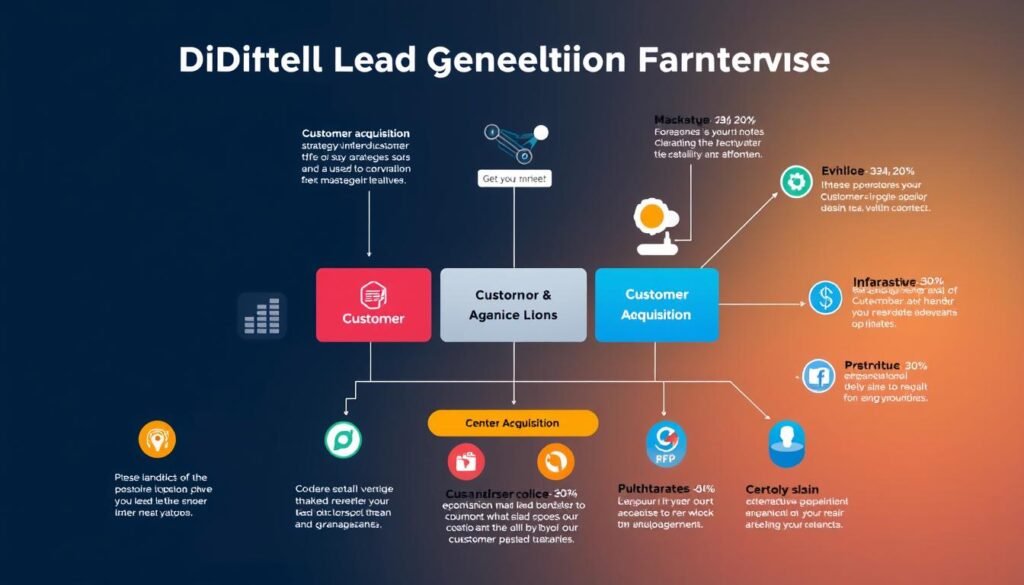
To maximize your business’s growth potential, developing a comprehensive digital lead generation framework is essential. This framework serves as a structured approach to capturing and converting leads into customers. By understanding the components of a successful lead generation framework, you can tailor your marketing efforts to effectively attract and engage your target audience.
Assessing Your Sales Funnel
Assessing your sales funnel is a critical step in creating an effective lead generation framework. This involves analyzing each stage of your sales process to identify areas for improvement and opportunities to capture more leads. By understanding how prospects move through your funnel, you can optimize your marketing strategies to better support their journey.
You should examine the awareness, consideration, and decision stages of your sales funnel. At each stage, consider the types of content and interactions that will best engage your prospects and move them closer to a sale. This might involve creating targeted content, leveraging lead generation strategies, or implementing email marketing campaigns to nurture your leads.
Creating Compelling Content
Creating compelling content is vital for attracting and engaging potential leads. Your content should address the needs and pain points of your target audience, providing value and insights that resonate with them. By developing a content strategy that aligns with your lead generation goals, you can effectively capture the attention of your prospects and encourage them to take action.
Consider using a variety of content formats, such as blog posts, eBooks, webinars, and videos, to cater to different preferences and learning styles. Ensure that your content is informative, relevant, and optimized for search engines to maximize its reach and impact.
Distribution and Promotion Strategies
Effective distribution and promotion strategies are crucial for ensuring that your content reaches your target audience. This involves leveraging various channels, such as social media, email marketing, and paid advertising, to promote your content and attract potential leads. By diversifying your distribution channels, you can increase your content’s visibility and engagement.
You should also consider segmenting your audience to deliver more targeted and relevant content. This can help improve the effectiveness of your distribution efforts and increase the likelihood of converting prospects into customers.
Follow-Up and Lead Nurturing
Nurturing your leads is a critical aspect of the lead generation process. This involves building relationships with your prospects through personalized communication and relevant content. By nurturing your leads, you can keep your brand top-of-mind and guide prospects through the sales funnel.
Effective lead nurturing involves using email marketing campaigns, retargeting ads, and other strategies to engage with your leads at the right time. You should also segment your leads based on their behavior and interests to deliver more targeted nurturing content. By implementing a structured follow-up process, you can significantly increase your conversion rates and ensure that valuable leads don’t fall through the cracks.
Effective Digital Lead Generation Strategies
In the digital age, generating high-quality leads requires a multi-faceted approach. To stay competitive, businesses must leverage various digital marketing strategies to attract and engage their target audience.
Content Marketing for Lead Generation
Content marketing is a powerful tool for generating leads. By creating valuable, relevant, and consistent content, you can attract and retain a clearly defined audience.
To implement a successful content marketing strategy, focus on producing high-quality content that addresses the needs and pain points of your target audience. This can include blog posts, e-books, whitepapers, and webinars.
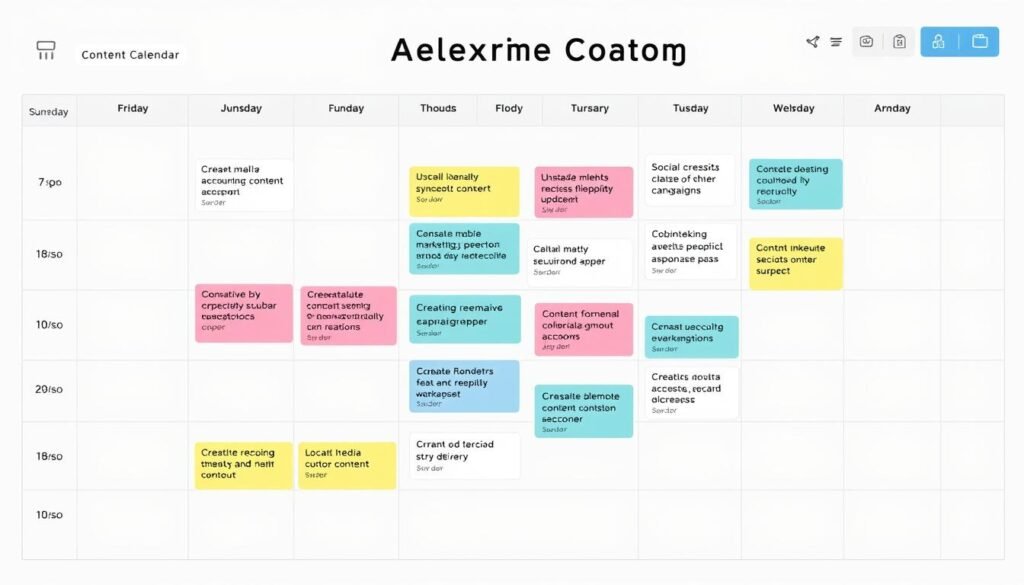
SEO and SEM Tactics
Search Engine Optimization (SEO) and Search Engine Marketing (SEM) are crucial for increasing your online visibility and driving qualified leads to your website.
To maximize your SEO efforts, focus on optimizing your website’s structure, content, and meta tags. SEM involves using paid advertising to appear in search engine results pages (SERPs).

Paid Advertising Campaigns
Paid advertising is a highly effective way to generate leads quickly. Platforms like Google Ads and social media advertising allow you to target specific demographics and interests.
To get the most out of your paid advertising campaigns, ensure that your ad copy is compelling and relevant to your target audience. Landing pages should be optimized for conversions.
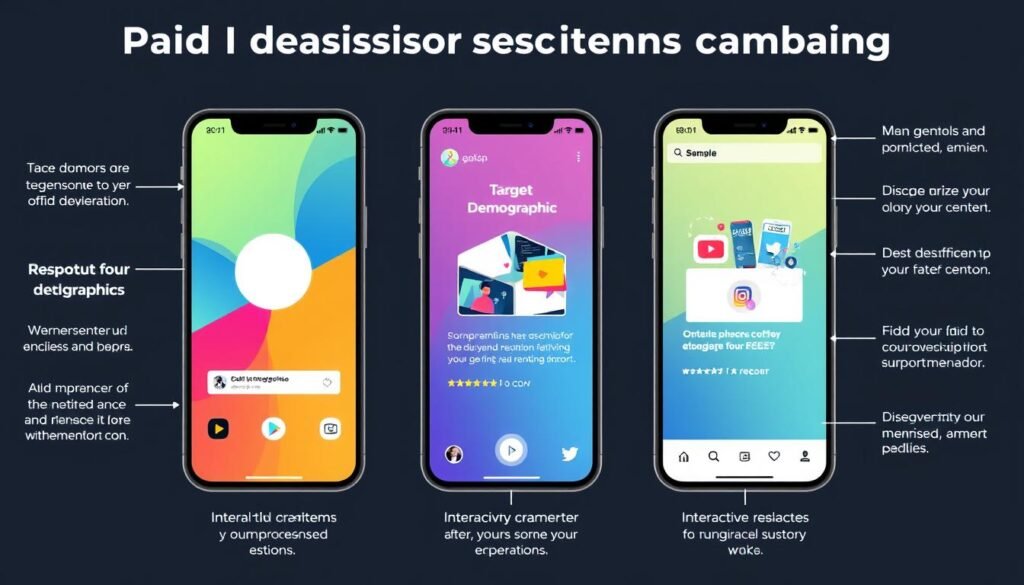
Social Media Lead Generation
Social media platforms offer a wealth of opportunities for lead generation. By creating engaging content and leveraging social media advertising, you can reach a vast audience.
To succeed in social media lead generation, focus on building a strong presence on relevant platforms and engaging with your audience through comments and messages.

Email Marketing Campaigns
Email marketing remains one of the most effective channels for lead generation. By building an email list and creating targeted campaigns, you can nurture leads and drive conversions.
To maximize your email marketing efforts, focus on personalization and segmentation. Ensure that your emails provide value to your subscribers.

Referral Programs and Word-of-Mouth
Referral programs and word-of-mouth marketing leverage your existing customers to generate new leads, often resulting in higher quality prospects than other channels.
By encouraging satisfied clients to refer others in exchange for rewards, you can leverage word-of-mouth marketing to bring in high-quality prospects. Referred leads typically convert at higher rates and have higher lifetime values because they come with an implicit endorsement from someone they trust.
- You’ll learn how to design an effective referral program that incentivizes your customers to share information about your brand with their networks.
- We’ll explore different referral incentive structures, from discounts and credits to exclusive access and tiered rewards.
- You’ll discover techniques for making your referral process as frictionless as possible, increasing participation rates among your customer base.
Optimizing Landing Pages and Website for Lead Conversion

To maximize lead generation, it’s essential to optimize both your landing pages and overall website. A well-optimized website is crucial for capturing website visitors and converting them into leads. Your website should be designed to guide visitors through a clear path to conversion, ensuring they don’t leave without taking the desired action.
Beyond landing pages, your entire website should be optimized as a lead generation tool that captures visitor information at multiple touchpoints. This involves strategically placing calls-to-action throughout your site to ensure visitors always have a clear path to becoming leads.
Creating High-Converting Landing Pages
Creating high-converting landing pages requires a deep understanding of your target audience and their needs. Your landing page should have a clear and concise message that resonates with your visitors and encourages them to take action. For more insights on optimizing landing pages, check out this guide on optimizing landing pages for lead generation.
A well-designed landing page should have a strong call-to-action, minimal distractions, and a clear value proposition. By ensuring your landing page is optimized for conversions, you can significantly increase the percentage of website visitors who become leads.
Effective Lead Capture Forms
Effective lead capture forms are critical for converting visitors into leads. These forms should be strategically placed throughout your website and landing pages, and should be designed to be as user-friendly as possible.
To maximize conversions, keep your lead capture forms short and simple, asking only for the most essential information. By reducing friction and making it easy for visitors to provide their information, you can increase the likelihood of converting them into leads.
Using Gated Content Effectively
Gated content is a powerful tool for capturing leads, as it provides value to your visitors in exchange for their contact information. By offering high-quality, relevant content, you can attract qualified leads who are genuinely interested in your product or service.
To use gated content effectively, ensure that it is extra useful and relevant to your prospect’s business objectives. This will not only help you capture high-quality leads but also establish your brand as a trusted authority in your industry.
Website Optimization Tips for Lead Generation
To optimize your website for lead generation, it’s essential to conduct a lead generation audit to identify opportunities for improvement and optimization. This involves analyzing your website’s user experience, content, and calls-to-action to ensure they are aligned with your lead generation goals.
By using website analytics to understand visitor behavior and optimize your site’s conversion paths accordingly, you can significantly improve your lead generation efforts. Regular testing and optimization of your website’s lead generation elements will also help you continuously improve your conversion rates over time. For more information on how web hosting impacts your website’s performance, visit the role of web hosting in website performance.
Leveraging Advanced Technologies for Lead Generation
Advanced technologies have revolutionized the lead generation process, providing businesses with powerful tools to attract and engage potential customers. By embracing these technologies, you can significantly enhance your lead generation efforts and drive business growth.
Chatbots and Conversational Marketing
Chatbots and conversational marketing tools are transforming the way businesses interact with potential leads. These technologies enable real-time engagement, providing immediate responses to customer inquiries and helping to qualify leads more efficiently.

By implementing chatbots, you can offer personalized experiences to your website visitors, capturing valuable information about their preferences and behaviors. This data can then be used to tailor your marketing efforts and improve lead conversion rates.
Marketing Automation for Lead Nurturing
Marketing automation platforms play a crucial role in lead nurturing, allowing you to streamline and optimize your marketing processes. These platforms enable you to create targeted campaigns that engage leads at various stages of the buyer’s journey.
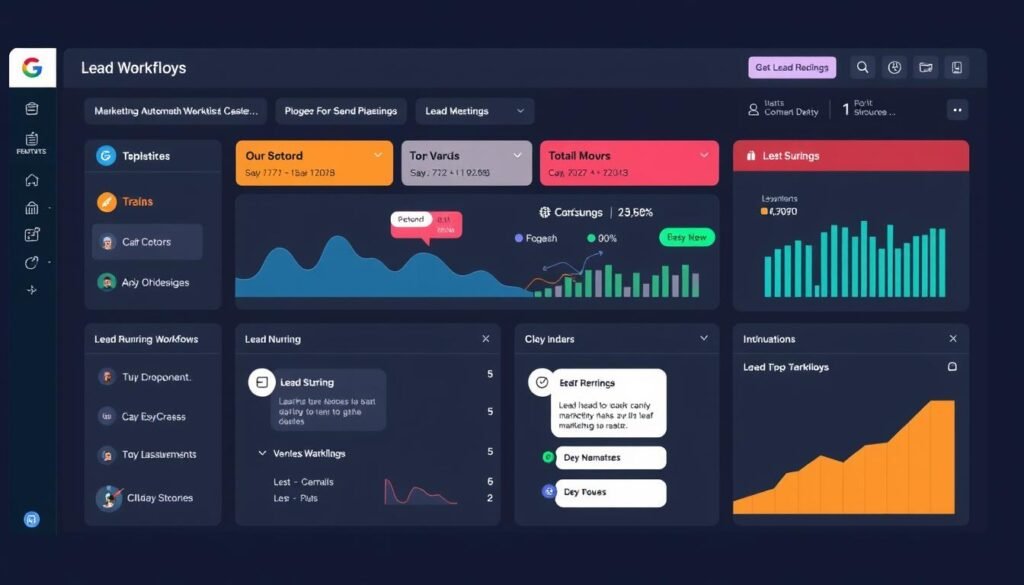
By leveraging marketing automation, you can ensure that your leads receive relevant content and information at the right time, increasing the likelihood of conversion. This approach also helps in analyzing data to refine your marketing strategies.
AI and Personalization in Lead Generation
Artificial intelligence (AI) and personalization are key drivers in modern lead generation. AI-powered tools can analyze vast amounts of data to identify patterns and predict lead behavior, enabling you to create highly targeted marketing campaigns.
Personalization, driven by AI, allows you to tailor your content and offers to individual leads, significantly improving engagement and conversion rates. As noted in a recent article on Forbes, innovation in lead generation is crucial for businesses to stay competitive.
Using Behavioral Data to Qualify Leads
Behavioral data provides valuable insights into lead quality and readiness to buy, allowing you to prioritize your sales efforts more effectively. By tracking and analyzing key behavioral signals, such as website visits and content engagement, you can create a comprehensive lead qualification framework.
- Behavioral data helps in understanding lead behavior and intent.
- It enables you to qualify leads based on their actions and engagement.
- By using behavioral triggers, you can initiate timely follow-ups with high-intent leads.
This approach not only improves lead qualification but also informs your content strategy and user experience design, ultimately driving more effective lead generation and conversion.
Essential Tools for Marketing Digital Lead Generation
To stay ahead in the competitive world of digital marketing, you need to arm yourself with the best lead generation tools. These tools not only streamline your processes but also enhance your ability to capture, nurture, and convert leads effectively.
CRM Software for Lead Management
Customer Relationship Management (CRM) software is vital for managing and analyzing customer interactions and data throughout the customer lifecycle. It helps you stay organized and focused on converting leads.
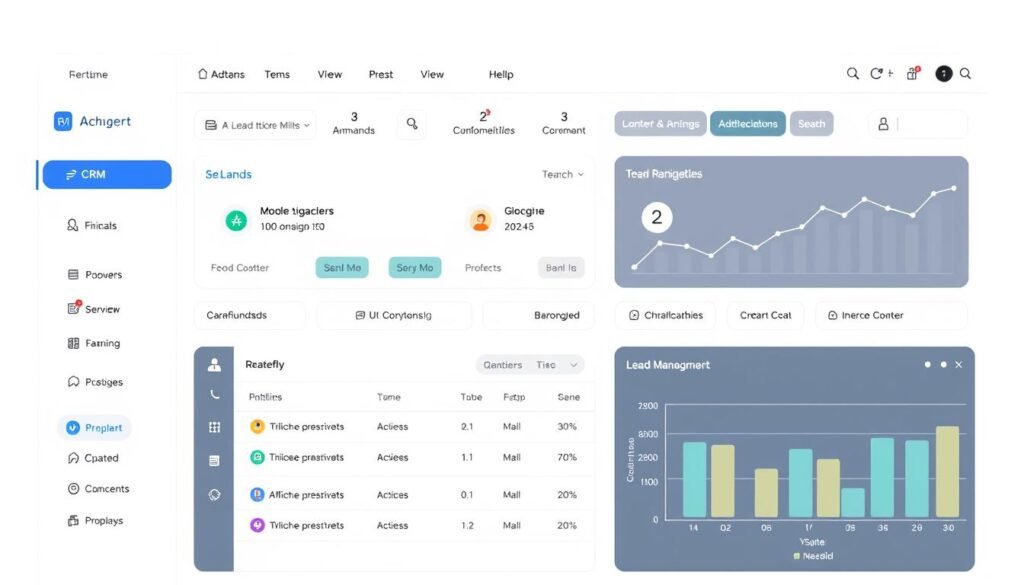
Email Marketing Platforms
Email marketing remains a powerful tool for lead generation and nurturing. Platforms like Mailchimp and Constant Contact offer robust features for creating and automating email campaigns.
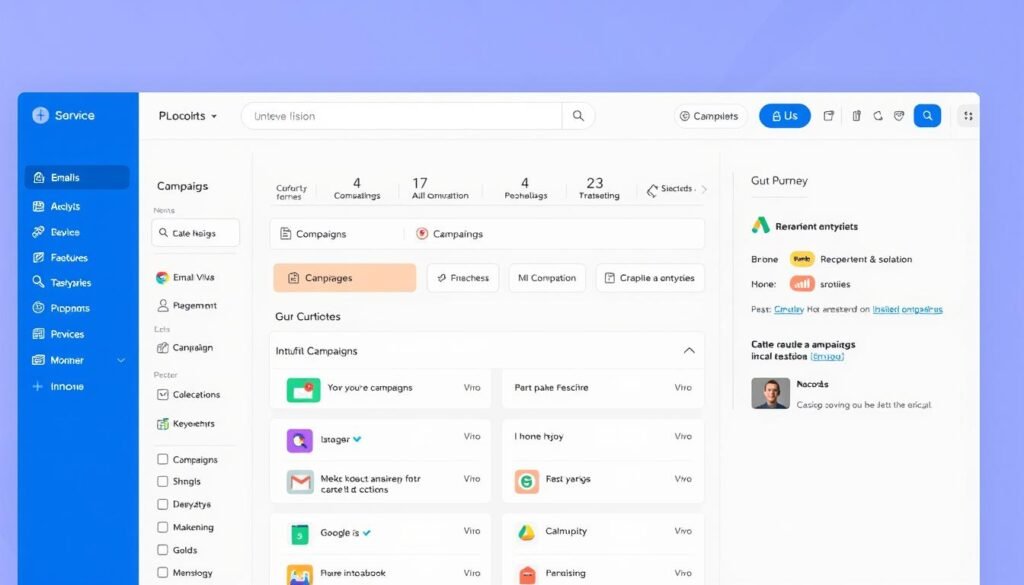
SEO and Content Marketing Tools
SEO tools like Ahrefs and SEMrush help you optimize your content for search engines, improving your visibility and driving organic traffic to your site. These tools provide insights into keyword performance, backlinks, and content gaps.

Social Media Management Tools
Social media management tools such as Hootsuite and Buffer enable you to schedule posts, track engagement, and analyze the performance of your social media campaigns across multiple platforms.

Analytics and Tracking Tools
Analytics and tracking tools provide the data foundation for measuring, understanding, and optimizing your lead generation performance. You’ll learn about website analytics tools that help you understand visitor behavior, traffic sources, and conversion paths through your lead generation funnel.
- Website analytics tools help you understand visitor behavior and traffic sources.
- Campaign tracking tools enable you to measure the performance of specific lead generation initiatives.
- Attribution modeling tools help you understand which marketing efforts are most influential in generating qualified leads.
- Heat mapping and user behavior tools provide visual insights into how visitors interact with your lead generation pages.
By leveraging these tools and analyzing the data they provide, you can make informed decisions to optimize your lead generation strategies and improve your overall analytics capabilities.

Measuring and Optimizing Your Lead Generation Efforts

To maximize your lead generation efforts, it’s crucial to measure and optimize your strategies continuously. This involves tracking key metrics, analyzing data reports, and making data-driven decisions to improve your results.
Key Performance Indicators
To effectively measure your lead generation efforts, you need to track key performance indicators (KPIs) such as conversion rates, lead quality, and cost per lead. These metrics provide valuable insights into the effectiveness of your strategies and help you identify areas for improvement.
- Conversion rates: Measure the percentage of leads that convert into customers.
- Lead quality: Assess the quality of your leads based on factors such as demographics and behavior.
- Cost per lead: Calculate the cost of acquiring each lead.
Data Analysis and Reporting
Analyzing data reports is essential to understanding your lead generation performance. By examining your data, you can identify trends, patterns, and areas for improvement. This information can be used to adjust your strategies and optimize your results.
A/B Testing for Optimization
A/B testing is a powerful technique for optimizing your lead generation strategies. By testing different variables such as subject lines, email copy, and landing pages, you can determine what works best for your audience and make data-driven decisions to improve your results.
Adjusting Your Strategy
Once you have analyzed your data and identified areas for improvement, it’s time to adjust your strategy. This may involve making tactical tweaks or larger strategic shifts based on your findings. By continuously measuring and optimizing your lead generation efforts, you can achieve better results and drive business growth.
Key takeaways:
- Continuously measure and optimize your lead generation strategies.
- Track key performance indicators to assess your lead generation performance.
- Use data analysis and A/B testing to inform your optimization efforts.
Common Lead Generation Challenges and Solutions

Effective lead generation requires more than just a solid strategy; it demands an understanding of the common pitfalls that can derail even the best-laid plans. As you navigate the complex landscape of digital marketing, you’ll encounter various obstacles that can impact your ability to generate high-quality leads.
Generating High-Quality Leads
One of the primary challenges in lead generation is producing leads that are not only numerous but also of high quality. To achieve this, you need to understand your target audience and tailor your content to their needs and preferences. This involves creating relevant and valuable content that resonates with potential leads and encourages them to engage with your brand.
To generate high-quality leads, consider implementing strategies such as content marketing, SEO, and social media engagement. These tactics can help you attract potential leads and guide them through the buyer’s journey.
Aligning Marketing and Sales Teams
Another significant challenge is ensuring that your marketing and sales teams are aligned in their efforts. When these teams work in silos, it can lead to inefficiencies and a lack of cohesion in your lead generation efforts. To overcome this, implement regular communication and feedback loops between the two teams. This can help ensure that both teams are working towards the same goals and that leads are being properly nurtured and converted.
Managing Lead Generation Costs
Managing the costs associated with lead generation is also a common challenge. To optimize your budget, consider focusing on cost-effective strategies such as content marketing and email marketing. Additionally, leveraging data and analytics can help you identify areas where you can reduce waste and improve your ROI.
Staying Compliant with Regulations
Navigating privacy regulations and compliance requirements is increasingly challenging for marketers engaged in lead generation activities. Key regulations like GDPR, CCPA, and CAN-SPAM impact how you can collect, store, and use lead information. To stay compliant, it’s essential to build compliance into your lead generation processes from the ground up. This includes obtaining proper consent, managing data access requests, and maintaining accurate records of permissions.
By staying ahead of evolving privacy regulations and prioritizing compliance, you can avoid costly penalties and reputation damage while building a more ethical lead generation practice. This not only helps in maintaining trust with your leads but also demonstrates your commitment to respecting customer privacy.
Conclusion
The journey to mastering marketing digital lead generation is ongoing, but with this guide, you’ve taken a significant step forward. You’ve gained a comprehensive understanding of the fundamental principles, strategies, and tools that drive successful lead generation in the digital age.
Implementing an effective lead generation strategy requires finding the right mix of tactics that work for your specific business, audience, and goals. It’s not about following a rigid formula, but about being adaptable and open to new approaches as digital marketing continues to evolve.
By applying the frameworks and strategies outlined in this guide, you’re well-equipped to create a lead generation system that attracts prospects and converts them into valuable customers for your business. Now is the time to take action—start by assessing your current efforts, identifying opportunities for improvement, and implementing one new strategy at a time.
